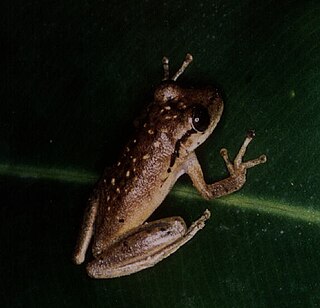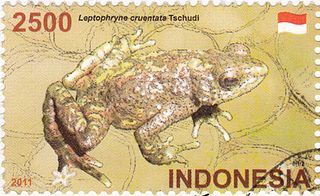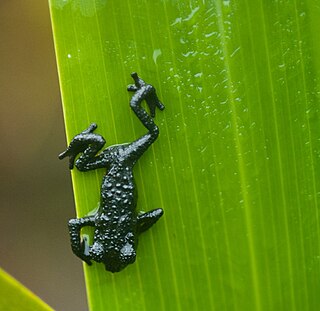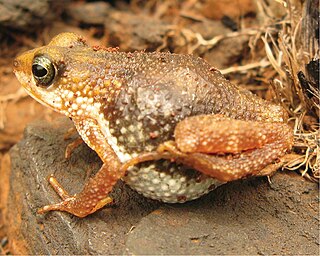
Melanophryniscus is a genus of toads in the family Bufonidae. They are found in northern half of Argentina, southern Bolivia, southern Brazil, Paraguay, and Uruguay. Common name South American redbelly toads has been coined for them.

Osteopilus is a genus of frogs in the family Hylidae. These species have a bony co-ossification on the skull resulting in a casque, hence its name ‘bone-cap’, from osteo- (‘bone’) and the Greek pilos. Color varies between uniform brown, brown-gray, or olive with darker markings or marbled with greens, grays or brown, making a distinct pattern. The finger disks are round; the fingers with a reduced webbing; eyes and tympanum are large. Their natural range includes the Greater Antilles and the Bahamas, but O. septentrionalis has also been introduced to the Lesser Antilles, Hawaii and Florida (USA).

Scinax is a genus of frogs in the family Hylidae found in eastern and southern Mexico to Argentina and Uruguay, Trinidad and Tobago, and Saint Lucia. These are small to moderate-sized tree frogs, drably colored. Duellman and Wiens resurrected this genus in 1992. The name originates from the Greek word skinos, meaning quick or nimble.

Tepuihyla, commonly known as Amazon tree frogs or Tepui tree frogs, is a genus of frogs in the family Hylidae found in mountains of eastern and south-eastern Venezuela and Guyana, and likely in adjacent Brazil. A tepui is a table-top mountain characteristic of the Guiana Highlands.

Trachycephalus is a genus of frogs, commonly known as the casque-headed tree frogs, in the family Hylidae. They are found in Mexico, Central America, and South America. In a recent revision, the seven species of the genus Phrynohyas were included in this genus, and Phrynohyas is now considered a synonym of Trachycephalus. These frogs inhabit the canopies of tropical rainforests, where they breed in tree cavities, and seldom, if ever, descend to the ground.

Triprion is a genus of frogs in the family Hylidae found in the Pacific lowlands of Mexico, the Yucatán Peninsula, and Guatemala. These frogs hide in tree-holes and plug the entrance with their strange-looking, bony heads.

Pseudacris is a genus of frogs in the family Hylidae found in North America ranging from the Pacific coastline to the Atlantic.

Phyllodytes is a genus of frogs in the family Hylidae. It is endemic to eastern Brazil.

Ansonia is a genus of true toads found in south India, northern Thailand, Malay Peninsula, Tioman Island, Borneo, and Mindanao (Philippines). These small forest species spawn in streams and have torrent-adapted tadpoles. Common name stream toads has been coined for the genus, although individual species are also being referred to as slender toads.

Capensibufo is a genus of true toads commonly known as Cape toads or mountain toadlets. They are found in the Republic of South Africa from Breede River to north of Knysna, Western Cape Province.

Leptophryne is a small genus of true toads, family Bufonidae, with only three species. The genus is found in Southeast Asia, in the Malay Peninsula and the Greater Sunda Islands. Its relationships within Bufonidae are uncertain; its closest relative might be Epidalea.

Nectophryne, or African tree toads, is a small genus of true toads with only two species. They are native to West and Central Africa: Nigeria, Cameroon, Gabon, northeastern Congo, Bioko and Equatorial Guinea. Nectophryne afra uses small bodies of water to lay its eggs which are then guarded by the male.

Oreophrynella, commonly known as bush toads, is a genus of true toads native to the tepuis of southern Venezuela and adjacent Guyana. The distribution of some species is restricted to a couple of tepuis or even a single tepui, as in the case of Oreophrynella weiassipuensis, which occurs on Wei-Assipu-tepui.

Osornophryne is a genus of true toads endemic to the Cordillera Central in Colombia and central Andes in Ecuador.
Werneria, also known as the torrent toads or smalltongue toads, is a small genus of "true toads", family Bufonidae. They are found in western Central Africa, with the greatest species richness in the Western High Plateau of Cameroon. The species generally have restricted or patchy distributions and are considered threatened.

Cophixalus is a genus of microhylid frogs. These are arboreal species with expanded toe-pads, endemic to Moluccan Islands, New Guinea and northeastern Queensland, Australia.
Wolterstorffina chirioi is a species of toad in the family Bufonidae. It is endemic to Cameroon and known only from Mount Oku, its type locality. The specific name chirioi honours Laurent Chirio, a herpetologist from the National Museum of Natural History, France; he also collected the holotype.
Werneria mertensiana is a species of toad in the family Bufonidae. It is found in western Cameroon and possibly in the Obudu Plateau in Nigeria. The specific name mertensiana honours Robert Mertens, a German zoologist and herpetologist. Common name Mertens' smalltongue toad has been coined for it.
Werneria tandyi, also known as Tandy's torrent toad or Tandy's smalltongue toad, is a species of toad in the family Bufonidae. It is endemic to western Cameroon and known from Mount Manengouba and from the Rumpi Hills. The specific name tandyi honours Robert Mills Tandy, biologist, herpetologist, and wildlife photographer.

Nimbaphrynoides is a monotypic genus of true toads from highlands in the Mount Nimba region of the West African countries of Guinea, Liberia, and Côte d'Ivoire. The sole species is Nimbaphrynoides occidentalis. Along with Nectophrynoides, Eleutherodactylus jasperi, and Limnonectes larvaepartus, Nimbaphrynoides is one of the only anurans that combine internal fertilization with ovoviviparity.
















